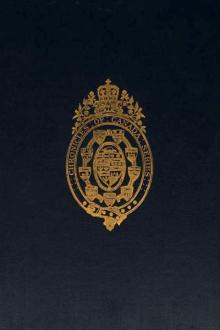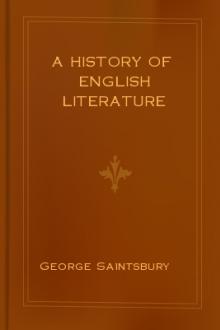The Dawn of Canadian History by Stephen Leacock (each kindness read aloud .TXT) 📕

Read free book «The Dawn of Canadian History by Stephen Leacock (each kindness read aloud .TXT) 📕» - read online or download for free at americanlibrarybooks.com
- Author: Stephen Leacock
- Performer: -
Read book online «The Dawn of Canadian History by Stephen Leacock (each kindness read aloud .TXT) 📕». Author - Stephen Leacock
The Mary of Guildford pursued her way alone, and her crew had adventures strange even for those days. Her course, set well to the north, brought her into the drift ice and the giant icebergs which are carried down the coast of America at this season (for the month was July) from the polar seas. In fear of the moving ice, she turned to the south, the sailors watching eagerly for the land, and sounding as they went. Four days brought them to the coast of Labrador. They followed it southward for some days. Presently they entered an inlet where they found a good harbour, many small islands, and the mouth of a great river of fresh water. The region was a wilderness, its mountains and woods apparently untenanted by man. Near the shore they saw the footmarks of divers great beasts, but, though they explored the country for about thirty miles, they saw neither men nor animals. At the end of July, they set sail again, and passed down the coast of Newfoundland to the harbour of St John's, already a well-known rendezvous. Here they found fourteen ships of the fishing fleet, mostly vessels from Normandy. From Newfoundland the Mary of Guildford pursued her way southward, and passed along the Atlantic coast of America. If she had had any one on board capable of accurate observation, even after the fashion of the time, or of making maps, the record of her voyage would have added much to the general knowledge of the continent. Unfortunately, the Italian pilot who directed the voyage was killed in a skirmish with Indians during a temporary landing. Some have thought that this pilot who perished on the Mary of Guildford may have been the great navigator Verrazano, of whom we shall presently speak.
The little vessel sailed down the coast to the islands of the West Indies. She reached Porto Rico in the middle of November, and from that island she made sail for the new Spanish settlements of San Domingo. Here, as she lay at her anchorage, the Mary of Guildford was fired upon by the Spanish fort which commanded the river mouth. At once she put out into the open sea, and, heading eastward across the Atlantic, she arrived safely at her port of London.
We have seen that after the return of the second expedition of the Cabots no voyages to the coasts of Canada of first-rate importance were made by the English. This does not mean, however, that nothing was done by other peoples to discover and explore the northern coasts of America. The Portuguese were the first after the Cabots to continue the search along the Canadian coast for the secret of the hidden East. At this time, we must remember, the Portuguese were one of the leading nations of Europe, and they were specially interested in maritime enterprise. Thanks to Columbus, the Spaniards had, it is true, carried off the grand prize of discovery. But the Portuguese had rendered service not less useful. From their coasts, jutting far out into the Atlantic, they had sailed southward and eastward, and had added much to the knowledge of the globe. For generations, both before and after Columbus, the pilots and sailors of Portugal were among the most successful and daring in the world.
For nearly a hundred years before the discovery of America the Portuguese had been endeavouring to find an ocean route to the spice islands of the East and to the great Oriental empires which, tradition said, lay far off on a distant ocean, and which Marco Polo and other travellers had reached by years of painful land travel across the interior of Asia. Prince Henry of Portugal was busy with these tasks at the middle of the fifteenth century. Even before this, Portuguese sailors had found their way to the Madeiras and the Canary Islands, and to the Azores, which lie a thousand miles out in the Atlantic. But under the lead of Prince Henry they began to grope their way down the coast of Africa, braving the torrid heats and awful calms of that equatorial region, where the blazing sun, poised overhead in a cloudless sky, was reflected on the bosom of a stagnant and glistening ocean. It was their constant hope that at some point the land would be found to roll back and disclose an ocean pathway round Africa to the East, the goal of their desire. Year after year they advanced farther, until at last they achieved a momentous result. In 1487, Bartholomew Diaz sailed round the southern point of Africa, which received the significant name of the 'Cape of Good Hope,' and entered the Indian Ocean. Henceforth a water pathway to the Far East was possible. Following Diaz, Vasco da Gama, leaving Lisbon in 1497, sailed round the south of Africa, and, reaching the ports of Hindustan, made the maritime route to India a definite reality.
Thus at the moment when the Spaniards were taking possession of the western world the Portuguese were establishing their trade in the rediscovered East. The two nations agreed to divide between them these worlds of the East and the West. They invoked the friendly offices of the Pope as mediator, and, henceforth, an imaginary line drawn down the Atlantic divided the realms. At first this arrangement seemed to give Spain all the new regions in America, but the line of division was set so far to the West that the discovery of Brazil, which juts out eastward into the Atlantic, gave the Portuguese a vast territory in South America. At the time of which we are now speaking, however, the Portuguese were intent upon their interests in the Orient. Their great aim was to pass beyond India, already reached by da Gama, to the further empires of China and Japan. Like other navigators of the time, they thought that these places might be reached not merely by southern but also by the northern seas. Hence it came about that the Portuguese, going far southward in Africa, went also far northward in America and sailed along the coast of Canada.
We find, in consequence, that when King Manoel of Portugal was fitting out a fleet of twenty ships for a new expedition under da Gama, which was to sail to the Indies by way of Africa, another Portuguese expedition, setting out with the same object, was sailing in the opposite direction. At its head was Gaspar Corte-Real, a nobleman of the Azores, who had followed with eager interest the discoveries of Columbus, Diaz, and da Gama. Corte-Real sailed from Lisbon in the summer of 1500 with a single ship. He touched at the Azores. It is possible that a second vessel joined him there, but this is not clear. From the Azores his path lay north and west, till presently he reached a land described as a 'cool region with great woods.' Corte-Real called it from its verdure 'the Green Land,' but the similarity of name with the place that we call Greenland is only an accident. In reality the Portuguese captain was on the coast of Newfoundland. He saw a number of natives. They appeared to the Portuguese a barbarous people, who dressed in skins, and lived in caves. They used bows and arrows, and had wooden spears, the points of which they hardened with fire.
Corte-Real directed his course northward, until he found himself off the coast of Greenland. He sailed for some distance along those rugged and forbidding shores, a land of desolation, with jagged mountains and furrowed cliffs, wrapped in snow and ice. No trace of the lost civilization of the Norsemen met his eyes. The Portuguese pilot considered Greenland at its southern point to be an outstanding promontory of Asia, and he struggled hard to pass beyond it westward to a more favoured region. But his path was blocked by 'enormous masses of frozen snow floating on the sea, and moving under the influence of the waves.' It is clear that he was met not merely by the field ice of the Arctic ocean, but also by great icebergs moving slowly with the polar current. The narrative tells how Corte-Real's crew obtained fresh water from the icebergs. 'Owing to the heat of the sun, fresh and clear water is melted on the summits, and, descending by small channels formed by the water itself, it eats away the base where it falls. The boats were sent in, and in that way as much was taken as was needed.'
Corte-Real made his way as far as a place (which was in latitude 60 degrees) where the sea about him seemed a flowing stream of snow, and so he called it Rio Nevado, 'the river of snow.' Probably it was Hudson Strait.
Late in the same season, Corte-Real was back in Lisbon. He had discovered nothing of immediate profit to the crown of Portugal, but his survey of the coast of North America from Newfoundland to Hudson Strait seems to have strengthened the belief that the best route to India lay in this direction. In any case, on May 15, 1501, he was sent out again with three ships. This time the Portuguese discovered a region, so they said, which no one had before visited. The description indicates that they were on the coast of Nova Scotia and the adjacent part of New England. The land was wooded with fine straight timber, fit for the masts of ships, and 'when they landed they found delicious fruits of various kinds, and trees and pines of marvellous height and thickness.' They saw many natives, occupied in hunting and fishing. Following the custom of the time, they seized fifty or sixty natives, and crowded these unhappy captives into the holds of their ships, to carry home as evidence of the reality of their discoveries, and to be sold as slaves. These savages are described by those who saw them in Portugal as of shapely form and gentle manner, though uncouth and even dirty in person. They wore otter skins, and their faces were marked with lines. The description would answer to any of the Algonquin tribes of the eastern coast. Among the natives seen on the coast there was a boy who had in his ears two silver rings of Venetian make. The circumstance led the Portuguese to suppose that they were on the coast of Asia, and that a European ship had recently visited the same spot. The true explanation, if the circumstance is correctly reported, would seem to be that the rings were relics of Cabot's voyages and of his trade in the trinkets supplied by the merchants.
Gaspar Corte-Real sent his consort ships home, promising to explore the coast further, and to return later in the season. The vessels duly reached Lisbon, bringing their captives and the news of the voyage. Corte-Real, however, never returned, nor is anything known of his fate.
When a year had passed with no news of Gaspar Corte-Real, his brother Miguel fitted out a new expedition of three ships and sailed westward in search of him. On reaching the coast of Newfoundland, the ships of Miguel Corte-Real separated in order





Comments (0)